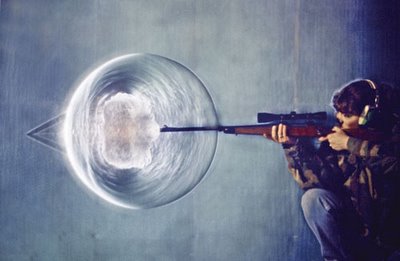The term I recall him using was 'skirlian' lines, but a couple of years later, out of school and in the work force, I was unable to locate a definition for the term. Over the years, I've searched now and then for the term - in dictionaries, on the web, wherever I could. Today, while perusing American Scientist at the grocery store (American Scientist in a grocery store magazine section! Have I mentioned I love Woodman's in Kenosha?), I saw the term again, spelled properly as 'Schlieren'. I imagine my prof had pronounced it incorrectly as 'sklee-ren', and my brain muddled it up with the word 'Kirlian' (as in Kirlian photography) over the years. Now, American Scientist was using the term to describe the effect as a means of visualizing shock waves, as when a rifle discharges.

A quick look around the web found a few definitions that were close, but finally, American Heritage Dictionary gave me a definition that seemed to fit:
2. Regions of a transparent medium, as of a flowing gas, that are visible because their densities are different from that of the bulk of the medium.
Google searches on Schlieren + concentration produced loads of hits describing the phenomenon I was familiar with. A decade and a half of searching is finally at an end. At last, the time for rest has come.
PS: This guy has some really cool Schlieren photographs. Check them out!


No comments:
Post a Comment